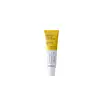What's inside
What's inside
 Key Ingredients
Key Ingredients

 Benefits
Benefits

 Concerns
Concerns

No concerns
 Ingredients Side-by-side
Ingredients Side-by-side

Water
Skin ConditioningZinc Oxide
Cosmetic ColorantButylene Glycol
HumectantButyloctyl Salicylate
Skin ConditioningCyclohexasiloxane
EmollientCoco-Caprylate/Caprate
EmollientPropylheptyl Caprylate
EmollientIsododecane
EmollientDicaprylyl Carbonate
EmollientDipropylene Glycol
HumectantAcrylates Copolymer
Caprylyl Methicone
Skin ConditioningDiphenylsiloxy Phenyl Trimethicone
Skin ConditioningNiacinamide
SmoothingCetyl Diglyceryl Tris(Trimethylsiloxy)Silylethyl Dimethicone
Emulsion StabilisingMagnesium Sulfate
Triethylhexanoin
MaskingDisteardimonium Hectorite
StabilisingMethyl Methacrylate Crosspolymer
Triethoxycaprylylsilane
Polyglyceryl-6 Polyricinoleate
Emulsifying1,2-Hexanediol
Skin ConditioningPolymethylsilsesquioxane
Polyglyceryl-2 Dipolyhydroxystearate
Skin ConditioningLauryl Dimethicone/Polyglycerin-3 Crosspolymer
CleansingCaprylyl Glycol
EmollientGlyceryl Caprylate
EmollientAdenosine
Skin ConditioningPanthenol
Skin ConditioningTocopherol
AntioxidantSodium Citrate
Buffering3-O-Ethyl Ascorbic Acid
Skin ConditioningAscorbic Acid
AntioxidantMadecassoside
AntioxidantAsiaticoside
AntioxidantMadecassic Acid
Skin ConditioningAsiatic Acid
Skin ConditioningWater, Zinc Oxide, Butylene Glycol, Butyloctyl Salicylate, Cyclohexasiloxane, Coco-Caprylate/Caprate, Propylheptyl Caprylate, Isododecane, Dicaprylyl Carbonate, Dipropylene Glycol, Acrylates Copolymer, Caprylyl Methicone, Diphenylsiloxy Phenyl Trimethicone, Niacinamide, Cetyl Diglyceryl Tris(Trimethylsiloxy)Silylethyl Dimethicone, Magnesium Sulfate, Triethylhexanoin, Disteardimonium Hectorite, Methyl Methacrylate Crosspolymer, Triethoxycaprylylsilane, Polyglyceryl-6 Polyricinoleate, 1,2-Hexanediol, Polymethylsilsesquioxane, Polyglyceryl-2 Dipolyhydroxystearate, Lauryl Dimethicone/Polyglycerin-3 Crosspolymer, Caprylyl Glycol, Glyceryl Caprylate, Adenosine, Panthenol, Tocopherol, Sodium Citrate, 3-O-Ethyl Ascorbic Acid, Ascorbic Acid, Madecassoside, Asiaticoside, Madecassic Acid, Asiatic Acid
Water
Skin ConditioningButylene Glycol
HumectantC12-15 Alkyl Benzoate
AntimicrobialEthylhexyl Methoxycinnamate
UV AbsorberTitanium Dioxide
Cosmetic ColorantBis-Ethylhexyloxyphenol Methoxyphenyl Triazine
Skin ConditioningDiethylamino Hydroxybenzoyl Hexyl Benzoate
UV FilterCyclopentasiloxane
EmollientSilica
AbrasiveCyclohexasiloxane
EmollientDiphenylsiloxy Phenyl Trimethicone
Skin Conditioning1,2-Hexanediol
Skin ConditioningPolyacrylate-13
Aluminum Stearate
Cosmetic ColorantPolyhydroxystearic Acid
EmulsifyingAlumina
AbrasivePolyisobutene
Stearic Acid
CleansingParfum
MaskingCaprylyl Glycol
EmollientCarbomer
Emulsion StabilisingDisodium EDTA
Ethylhexylglycerin
Skin ConditioningPolysorbate 20
EmulsifyingSorbitan Isostearate
EmulsifyingCI 77491
Cosmetic ColorantCI 77492
Cosmetic ColorantCeramide NP
Skin ConditioningPropanediol
SolventBHT
AntioxidantCentella Asiatica Flower/Leaf/Stem Extract
Skin ConditioningAcorus Calamus Root Extract
PerfumingTocopherol
AntioxidantAcetyl Tetrapeptide-5
HumectantWater, Butylene Glycol, C12-15 Alkyl Benzoate, Ethylhexyl Methoxycinnamate, Titanium Dioxide, Bis-Ethylhexyloxyphenol Methoxyphenyl Triazine, Diethylamino Hydroxybenzoyl Hexyl Benzoate, Cyclopentasiloxane, Silica, Cyclohexasiloxane, Diphenylsiloxy Phenyl Trimethicone, 1,2-Hexanediol, Polyacrylate-13, Aluminum Stearate, Polyhydroxystearic Acid, Alumina, Polyisobutene, Stearic Acid, Parfum, Caprylyl Glycol, Carbomer, Disodium EDTA, Ethylhexylglycerin, Polysorbate 20, Sorbitan Isostearate, CI 77491, CI 77492, Ceramide NP, Propanediol, BHT, Centella Asiatica Flower/Leaf/Stem Extract, Acorus Calamus Root Extract, Tocopherol, Acetyl Tetrapeptide-5
Ingredients Explained
These ingredients are found in both products.
Ingredients higher up in an ingredient list are typically present in a larger amount.
1,2-Hexanediol is a synthetic liquid and another multi-functional powerhouse.
It is a:
- Humectant, drawing moisture into the skin
- Emollient, helping to soften skin
- Solvent, dispersing and stabilizing formulas
- Preservative booster, enhancing the antimicrobial activity of other preservatives
Butylene Glycol (or BG) is used within cosmetic products for a few different reasons:
Overall, Butylene Glycol is a safe and well-rounded ingredient that works well with other ingredients.
Though this ingredient works well with most skin types, some people with sensitive skin may experience a reaction such as allergic rashes, closed comedones, or itchiness.
Learn more about Butylene GlycolCaprylyl Glycol is a humectant and emollient, meaning it attracts and preserves moisture.
It is a common ingredient in many products, especially those designed to hydrate skin. The primary benefits are retaining moisture, skin softening, and promoting a healthy skin barrier.
Though Caprylyl Glycol is an alcohol derived from fatty acids, it is not the kind that can dry out skin.
This ingredient is also used as a preservative to extend the life of products. It has slight antimicrobial properties.
Learn more about Caprylyl GlycolCyclohexasiloxane is a type of silicone more commonly known as D6. It is an emollient and solvent.
Cyclohexasiloxane is used to evenly distribute ingredients throughout the product. When applied to the skin, Cyclohexasiloxane evaporates and leaves behind a silky feel.
As an emollient, it can help the skin feel soft and hydrated. It is also used to reduce frizz in hair products.
Learn more about CyclohexasiloxaneDiphenylsiloxy Phenyl Trimethicone is a silicone. It has a high refractive index and adds shine to formulations.
According to the safety review by the Cosmetic Ingredient Review (CIR) Expert Panel, it is safe for use in cosmetics under the current practices and concentrations.
Tocopherol (also known as Vitamin E) is a common antioxidant used to help protect the skin from free-radicals and strengthen the skin barrier. It's also fat soluble - this means our skin is great at absorbing it.
Vitamin E also helps keep your natural skin lipids healthy. Your lipid skin barrier naturally consists of lipids, ceramides, and fatty acids. Vitamin E offers extra protection for your skin’s lipid barrier, keeping your skin healthy and nourished.
Another benefit is a bit of UV protection. Vitamin E helps reduce the damage caused by UVB rays. (It should not replace your sunscreen). Combining it with Vitamin C can decrease sunburned cells and hyperpigmentation after UV exposure.
You might have noticed Vitamin E + C often paired together. This is because it is great at stabilizing Vitamin C. Using the two together helps increase the effectiveness of both ingredients.
There are often claims that Vitamin E can reduce/prevent scarring, but these claims haven't been confirmed by scientific research.
Learn more about TocopherolWater. It's the most common cosmetic ingredient of all. You'll usually see it at the top of ingredient lists, meaning that it makes up the largest part of the product.
So why is it so popular? Water most often acts as a solvent - this means that it helps dissolve other ingredients into the formulation.
You'll also recognize water as that liquid we all need to stay alive. If you see this, drink a glass of water. Stay hydrated!
Learn more about Water